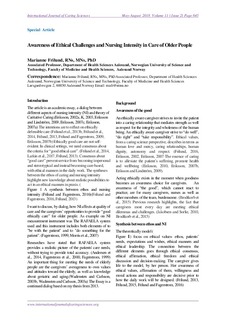| dc.description.abstract | The article is an academic essay, a dialog between different aspects of nursing intensity (NI) and theory of Caritative Caring.(Eriksson, 2002a, K, 2003, Eriksson and Lindström, 2009, Eriksson, 2007c, Eriksson, 2007a) The intentions are to reflect on ethically defensible care (Frilund et al., 2013b, Frilund et al., 2014, Frilund, 2013, Frilund and Fagerstrom, 2009, Eriksson, 2007b) Ethically good care are not selfevident. In clinical settings, we need consensus about the criteria for “good ethical care”. (Frilund et al., 2014, Larkin et al., 2017, Frilund, 2013). Consensus about “good care” prevent service from becoming impersonal and stereotypical and instead becoming care-based, with ethical manners in the daily work. The syntheses between the ethos of caring and nursing intensity highlight new knowledge about realistic possibilities to act in an ethical manners in praxis. ( Figure 1 A synthesis between ethos and nursing intensity (Frilund and Fagerstrom, 2016)(Frilund and Fagerstrom, 2016, Frilund, 2013)
I want to discuss, by dialog, how NI affects at quality of care and the caregivers’ opportunities to provide “good ethically care” for older people. As example on NI measurement instrument was The RAFAELA system used and this instrument includes both elements of to "be with the patient" and to "do something for the patient". (Fagerstrom, 1999, Morris et al., 2007) Researches have stated that RAFAELA system
provides a realistic picture of the patients' care needs, without trying to provide total accuracy. (Andersen et al., 2014, Fagerstrom et al., 2000, Fagerstrom, 1999) An important thing for meeting the needs of elderly people are the caregivers’ averageness to own values and attitudes toward the elderly, as well as knowledge about geriatric and aging.(Wadensten and Carlsson, 2003b, Wadensten and Carlsson, 2003a) The Essay is a continued dialog based on my thesis from 2013. | nb_NO |

